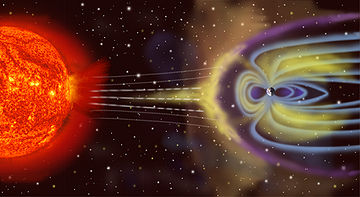 |
| Artistic rendition(not real) |
Earth's Magnetosphere:
The magnetosphere of Earth is a region in space whose shape is determined by the Earth's internal magnetic field, the solar wind plasma, and the interplanetary magnetic field (IMF). The boundary of the magnetosphere ("magnetopause") is roughly bullet shaped, about 15 RE abreast of Earth and on the night side (in the "magnetotail" or "geotail") approaching a cylinder with a radius 20-25 RE. The tail region stretches well past 200 RE, and the way it ends is not well known.
The outer neutral gas envelope of Earth, or geocorona, consists mostly of the lightest atoms, hydrogen and helium, and continues beyond 4-5 RE, with diminishing density. The hot plasma ions of the magnetosphere acquire electrons during collisions with these atoms and create an escaping "glow" of energetic neutral atoms (ENAs) that have been used to image the hot plasma clouds by the IMAGE and TWINS missions.
The upward extension of the ionosphere, known as the plasmasphere, also extends beyond 4-5 RE with diminishing density, beyond which it becomes a flow of light ions called the polar wind that escapes out of the magnetosphere into the solar wind. Energy deposited in the ionosphere by auroras strongly heats the heavier atmospheric components such as oxygen and molecules of oxygen and nitrogen, which would not otherwise escape from Earth's gravity. Owing to this highly variable heating, however, a heavy atmospheric or ionospheric outflow of plasma flows during disturbed periods from the auroral zones into the magnetosphere, extending the region dominated by terrestrial material, known as the fourth or plasma geosphere, at times out to the magnetopause.
Earth’s magnetosphere protects the ozone layer from the solar wind. The ozone layer protects the Earth (and life on it) from dangerous ultraviolet radiation.






0 comments:
Post a Comment